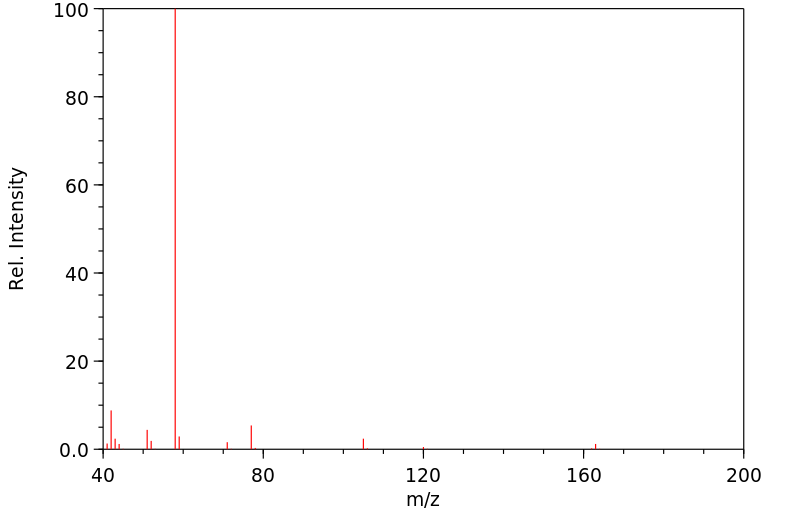2-二甲基氨基-1-苯乙酮 | 3319-03-7
中文名称
2-二甲基氨基-1-苯乙酮
中文别名
2-(N,N-二甲氨基)对苯甲酮
英文名称
2-dimethylamino-1-phenyl-ethanone
英文别名
Ethanone, 2-(dimethylamino)-1-phenyl-;2-(dimethylamino)-1-phenylethanone
CAS
3319-03-7
化学式
C10H13NO
mdl
MFCD12146017
分子量
163.219
InChiKey
UMLWXYJZDNNBTD-UHFFFAOYSA-N
BEILSTEIN
——
EINECS
——
-
物化性质
-
计算性质
-
ADMET
-
安全信息
-
SDS
-
制备方法与用途
-
上下游信息
-
文献信息
-
表征谱图
-
同类化合物
-
相关功能分类
-
相关结构分类
物化性质
-
沸点:126-128 °C(Press: 13 Torr)
-
密度:1.012±0.06 g/cm3(Predicted)
-
溶解度:可溶于二氯甲烷、乙胺
计算性质
-
辛醇/水分配系数(LogP):1.7
-
重原子数:12
-
可旋转键数:3
-
环数:1.0
-
sp3杂化的碳原子比例:0.3
-
拓扑面积:20.3
-
氢给体数:0
-
氢受体数:2
安全信息
-
海关编码:2922399090
SDS
上下游信息
反应信息
-
作为反应物:描述:参考文献:名称:Beiträge zum Problem der Beziehungen zwischen Konstitution und Wirkung. 1,1-Diaryl-2=aminoalkanole-(1)摘要:DOI:10.1002/ardp.19422800202
-
作为产物:描述:参考文献:名称:涉及叶立德中间体的碱催化重排。第8部分。稳定的酰化铵的制备及一些反应摘要:羰基稳定的铵化铵(3),(12a–n)和(14a–c)是由相应的卤化铵(1),(13a–n)和(15a–c)与钠反应制得的在水或甲醇水溶液中的氢氧化物。由其分子式和光谱性质表征的叶立德在用氢溴酸处理后再生了季铵溴化物。通常,铵盐的反应类似于相应的the盐的反应。因此,具有适当迁移基团的亚烷基(ArCH 2)在加热下进行史蒂文斯[1,2]重排,以及其他酰基片段断裂,得到叔胺和含有PhCOCH基团的产物。许多酰化物与乙炔二甲酸二甲酯反应生成呋喃(32)。具有异氰酸苯酯的酰化物(14b和c)得到苯基氨基甲酰基取代的酰化物(35)。DOI:10.1039/p19810001154
文献信息
-
Hydrophobically Directed Selective Reduction of Ketones作者:Mark R. Biscoe、Ronald BreslowDOI:10.1021/ja0379924日期:2003.10.1extreme case, there was a 40-fold selectivity reversal. Lithium borohydride showed no such change in selectivity and favored acetyl reduction in both solvents. Salt and cosolvent effects indicate that hydrophobic packing is involved in the reaction of hydrophobic reagents with the aryl ketones. Some special interaction of the pentafluorophenyl group with aryl rings was also detected.
-
Direct synthesis of 2-oxo-acetamidines from methyl ketones, aromatic amines and DMF <i>via</i> copper-catalyzed C(sp<sup>3</sup>)–H amidination作者:Dianke Xie、Wei He、Jiang Xiao、Yao Wu、Yongjia Guo、Qiang Liu、Cancheng GuoDOI:10.1039/c9ra00616h日期:——2-oxo-acetamidines from methyl ketones using aromatic amines and DMF as nitrogen sources is reported via copper-catalyzed C(sp3)–H amidination. Various methyl ketones react readily with aromatic amines and DMF, producing 2-oxo-acetamidines in yields of 47 to 92%. This protocol features the simultaneous formation of C–N and CN bonds using DMF and aromatic amines as two different nitrogen sources. It
-
Enantioselective reduction of α-substituted ketones mediated by the boronate ester TarB-NO2作者:Scott Eagon、Nicholas Ball-Jones、Dustin Haddenham、Jaime Saavedra、Cassandra DeLieto、Matthew Buckman、Bakthan SingaramDOI:10.1016/j.tetlet.2010.09.146日期:2010.12A facile and mild reduction procedure is reported for the preparation of chiral secondary alcohols prepared from α-substituted ketones using sodium borohydride and the chiral boronate ester (l)-TarB-NO2. Direct reduction of substituted ketones bearing Lewis basic heteroatoms generally provided secondary alcohols of only modest enantiomeric excess likely due to either competition between the target
-
Acrylic ester compound and usage thereof申请人:——公开号:US20020061995A1公开(公告)日:2002-05-23An acrylic ester compound represented by the general formula (1): 1 wherein, R 1 and R 2 represent independently a hydrogen atom, an alkyl group which may have a substituent, an aromatic alkyl group which may have a substituent or an aromatic residue which may have a substituent, respectively; R 3 represents a hydrogen atom or an alkyl group; A represents a divalent organic group; and X represents a sulfur atom or an oxygen atom; provided that when X is an oxygen atom, R 1 represents an aromatic residue that may have a substituent, a polymerizable composition comprising the compound, and a cured article and optical components obtained by polymerizing the polymerizable composition.
-
Nickel-catalyzed C–N bond reduction of aromatic and benzylic quaternary ammonium triflates作者:Yuan-Qiu-Qiang Yi、Wen-Cheng Yang、Dan-Dan Zhai、Xiang-Yu Zhang、Shuai-Qi Li、Bing-Tao GuanDOI:10.1039/c6cc04531f日期:——A nickel-catalyzed, efficient C-N bond reduction of aromatic and benzylic ammonium triflates has been developed using sodium isopropoxide as a reducing agent. The high efficiency, mild conditions, and nice compatibility...
表征谱图
-
氢谱1HNMR
-
质谱MS
-
碳谱13CNMR
-
红外IR
-
拉曼Raman
-
峰位数据
-
峰位匹配
-
表征信息
同类化合物
(反式)-4-壬烯醛
(s)-2,3-二羟基丙酸甲酯
([1-(甲氧基甲基)-1H-1,2,4-三唑-5-基](苯基)甲酮)
(Z)-4-辛烯醛
(S)-氨基甲酸酯β-D-O-葡糖醛酸
(S)-3-(((2,2-二氟-1-羟基-7-(甲基磺酰基)-2,3-二氢-1H-茚满-4-基)氧基)-5-氟苄腈
(R)-氨基甲酸酯β-D-O-葡糖醛酸
(5,5-二甲基-2-(哌啶-2-基)环己烷-1,3-二酮)
(2,5-二氟苯基)-4-哌啶基-甲酮
龙胆苦苷
龙胆二糖甲乙酮氰醇(P)
龙胆二糖丙酮氰醇(P)
龙胆三糖
龙涎酮
齐罗硅酮
齐留通beta-D-葡糖苷酸
鼠李糖
黑芥子苷单钾盐
黑海棉酸钠盐
黑木金合欢素
黑曲霉三糖
黑介子苷
黄尿酸8-O-葡糖苷
麻西那霉素II
麦迪霉素
麦芽糖脎
麦芽糖基海藻糖
麦芽糖1-磷酸酯
麦芽糖
麦芽四糖醇
麦芽四糖
麦芽十糖
麦芽六糖
麦芽五糖水合物
麦芽五糖
麦芽五糖
麦芽五糖
麦芽三糖醇
麦芽三糖
麦芽三糖
麦芽三塘水合
麦芽七糖水合物
麦芽七糖
麦法朵
麦可酚酸-酰基-Β-D-葡糖苷酸
麦利查咪
麝香酮
鹤草酚
鸢尾酚酮 3-C-beta-D-吡喃葡萄糖苷
鸡矢藤苷







